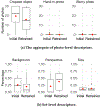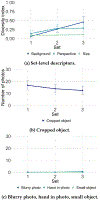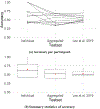Blind Users Accessing Their Training Images in Teachable Object Recognizers
- PMID: 36916963
- PMCID: PMC10008526
- DOI: 10.1145/3517428.3544824
Blind Users Accessing Their Training Images in Teachable Object Recognizers
Abstract
Teachable object recognizers provide a solution for a very practical need for blind people - instance level object recognition. They assume one can visually inspect the photos they provide for training, a critical and inaccessible step for those who are blind. In this work, we engineer data descriptors that address this challenge. They indicate in real time whether the object in the photo is cropped or too small, a hand is included, the photos is blurred, and how much photos vary from each other. Our descriptors are built into open source testbed iOS app, called MYCam. In a remote user study in (N = 12) blind participants' homes, we show how descriptors, even when error-prone, support experimentation and have a positive impact in the quality of training set that can translate to model performance though this gain is not uniform. Participants found the app simple to use indicating that they could effectively train it and that the descriptors were useful. However, many found the training being tedious, opening discussions around the need for balance between information, time, and cognitive load.
Keywords: blind; machine teaching; object recognition; participatory machine learning; visual impairment.
Figures














Similar articles
-
Understanding How Blind Users Handle Object Recognition Errors: Strategies and Challenges.ASSETS. 2024;2024:1-15. doi: 10.1145/3663548.3675635. ASSETS. 2024. PMID: 40028444 Free PMC article.
-
Revisiting Blind Photography in the Context of Teachable Object Recognizers.ASSETS. 2019 Oct;2019:83-95. doi: 10.1145/3308561.3353799. ASSETS. 2019. PMID: 32783045 Free PMC article.
-
Hands Holding Clues for Object Recognition in Teachable Machines.Proc SIGCHI Conf Hum Factor Comput Syst. 2019 May;2019:336. doi: 10.1145/3290605.3300566. Proc SIGCHI Conf Hum Factor Comput Syst. 2019. PMID: 32043091 Free PMC article.
-
Designing accessible and independent living spaces for visually impaired individuals: a barrier-free approach to interior design.Int J Equity Health. 2025 May 15;24(1):137. doi: 10.1186/s12939-025-02503-5. Int J Equity Health. 2025. PMID: 40375267 Free PMC article. Review.
-
Remotely delivered information, training and support for informal caregivers of people with dementia.Cochrane Database Syst Rev. 2021 Jan 4;1(1):CD006440. doi: 10.1002/14651858.CD006440.pub3. Cochrane Database Syst Rev. 2021. PMID: 33417236 Free PMC article.
Cited by
-
AccessShare: Co-designing Data Access and Sharing with Blind People.ASSETS. 2024;4:1-16. doi: 10.1145/3663548.3675612. ASSETS. 2024. PMID: 40568023 Free PMC article.
-
Contributing to Accessibility Datasets: Reflections on Sharing Study Data by Blind People.Proc SIGCHI Conf Hum Factor Comput Syst. 2023 Apr;2023:827. doi: 10.1145/3544548.3581337. Epub 2023 Apr 19. Proc SIGCHI Conf Hum Factor Comput Syst. 2023. PMID: 38545919 Free PMC article.
-
Understanding How Blind Users Handle Object Recognition Errors: Strategies and Challenges.ASSETS. 2024;2024:1-15. doi: 10.1145/3663548.3675635. ASSETS. 2024. PMID: 40028444 Free PMC article.
-
Beyond Visual Perception: Insights from Smartphone Interaction of Visually Impaired Users with Large Multimodal Models.Proc SIGCHI Conf Hum Factor Comput Syst. 2025 Apr-May;25:62. doi: 10.1145/3706598.3714210. Epub 2025 Apr 25. Proc SIGCHI Conf Hum Factor Comput Syst. 2025. PMID: 40792292 Free PMC article.
-
Human-AI Collaboration for Remote Sighted Assistance: Perspectives from the LLM Era.Future Internet. 2024 Jul;16(7):254. doi: 10.3390/fi16070254. Epub 2024 Jul 18. Future Internet. 2024. PMID: 40051468 Free PMC article.
References
-
- Abdolrahmani Ali, Easley William, Williams Michele, Branham Stacy, and Hurst Amy. 2017. Embracing Errors: Examining How Context of Use Impacts Blind Individuals’ Acceptance of Navigation Aid Errors. In Proceedings of the 2017 CHI Conference on Human Factors in Computing Systems (Denver, Colorado, USA) (CHI ’17). Association for Computing Machinery, New York, NY, USA, 4158–4169. 10.1145/3025453.3025528 - DOI
-
- Ahmetovic Dragan, Bernareggi Cristian, Gerino Andrea, and Mascetti Sergio. 2014. ZebraRecognizer: Efficient and Precise Localization of Pedestrian Crossings. In 2014 22nd International Conference on Pattern Recognition. 2566–2571. 10.1109/ICPR.2014.443 - DOI
-
- Ahmetovic Dragan, Sato Daisuke, Oh Uran, Ishihara Tatsuya, Kitani Kris, and Asakawa Chieko. 2020. ReCog: Supporting Blind People in Recognizing Personal Objects. Association for Computing Machinery, New York, NY, USA, 1–12. 10.1145/3313831.3376143 - DOI
-
- Aira. 2017. Your Life, Your Schedule, Right Now. https://aira.io
-
- Akter Taslima, Dosono Bryan, Ahmed Tousif, Kapadia Apu, and Semaan Bryan. 2020. "I am uncomfortable sharing what I can’t see": Privacy Concerns of the Visually Impaired with Camera Based Assistive Applications. In 29th USENIX Security Symposium (USENIX Security 20). USENIX Association, 1929–1948. https://www.usenix.org/conference/usenixsecurity20/presentation/akter
Grants and funding
LinkOut - more resources
Full Text Sources
